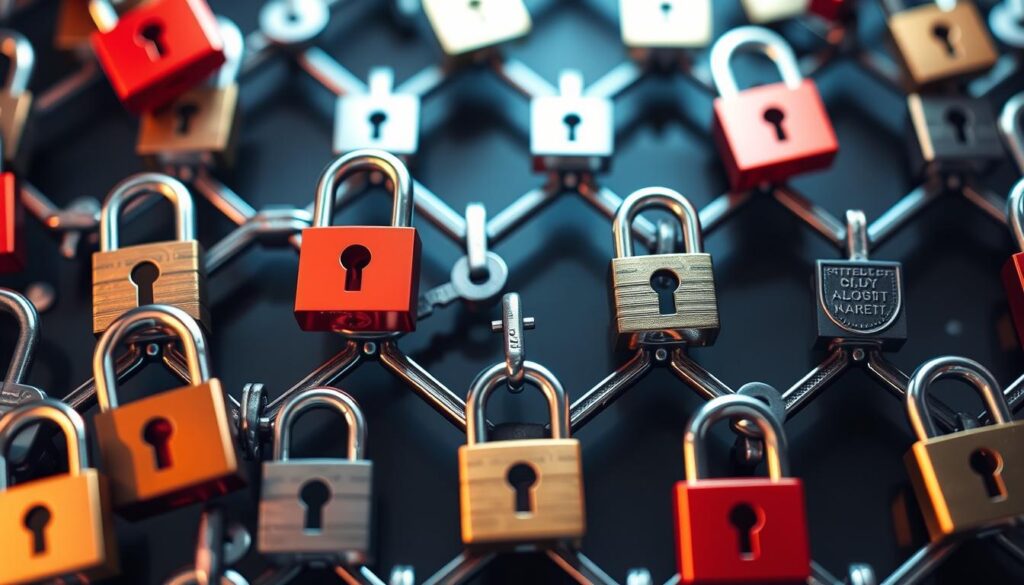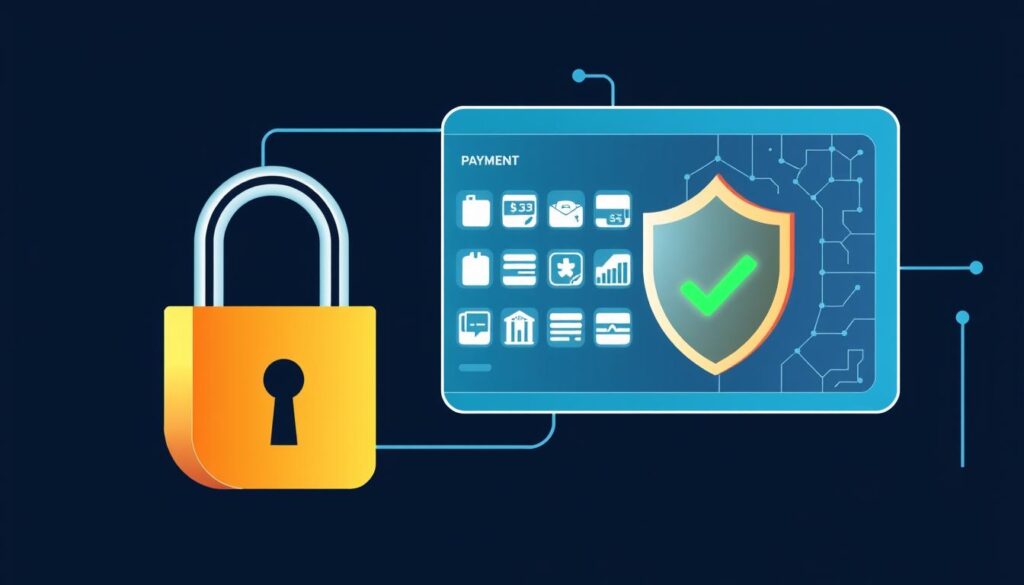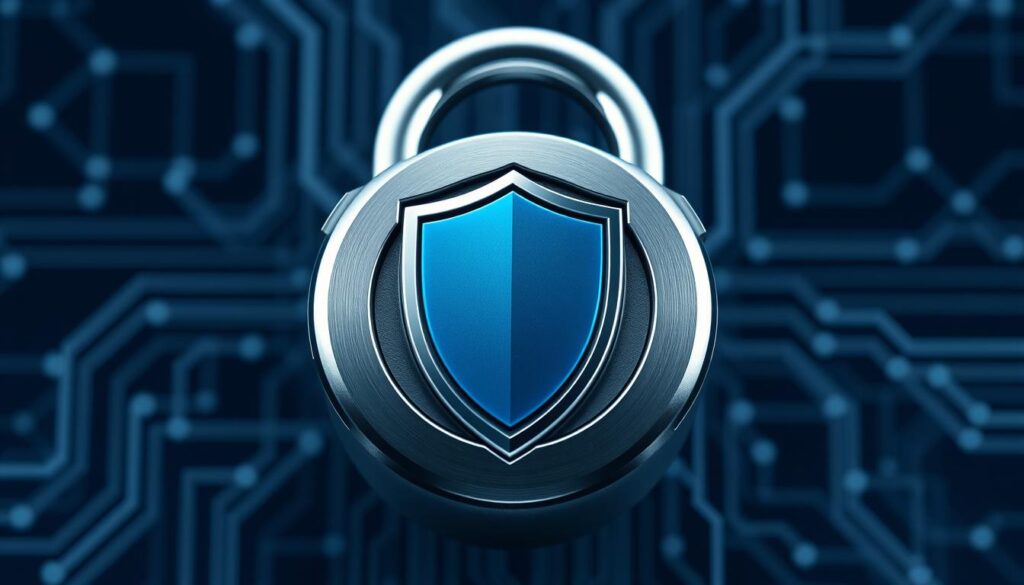Did you know that 50% of all online financial transactions are at risk of fraud? With more people using digital payments and cyber attacks on the rise, keeping your online money transfers safe is key. This guide will show you how to protect your financial transactions and keep your money safe.
Key Takeaways
- Understand the importance of secure online payment methods to protect against fraud and identity theft.
- Explore the latest encryption protocols and tokenization techniques for enhanced transaction security.
- Discover the most secure money transfer services and learn how to leverage their security features.
- Implement best practices for mobile wallet safety and peer-to-peer transfer security.
- Stay informed about emerging trends in online payment security to keep your financial transactions safe.
What is Secure Online Money Transfer?
When you send money online, keeping it safe is key. A secure payments system (SPS) is a way to protect your business from fraud, especially in online shopping. It uses things like encryption, tokenization, multi-factor authentication, and fraud prevention tools to stay safe.
Defining Secure Payment Systems
Secure payment systems keep your financial info safe and make sure online transactions are secure. They follow rules like PCI DSS and EMV to make sure they’re doing things right. These rules help them use strong security steps and best practices.
Key Components of Secure Payment Processing
Secure payments systems use many technologies to protect your business. These include:
- Encryption to make sensitive data unreadable
- Tokenization to change sensitive data into unique codes
- Multi-factor authentication to check your identity in more ways
- Fraud prevention systems that watch for and stop suspicious activities
With these strong security steps, secure payments systems lower the risk of data theft and fraud. This makes online payments safe and trustworthy for both businesses and customers.

Why Secure Payment Processing Matters
Online transactions are at high risk of data breaches. Cybercriminals try to get into systems to steal customer info. It’s key to keep this data safe to prevent fraud against businesses and people.
Online merchants face many fraud risks every day. Secure payment processing uses fraud detection to check transactions. It looks for suspicious activity and stops fraud in real-time with machine learning.
Protect Sensitive Data
PCI DSS rules require you to keep customer card data safe from fraud. If you’re in the EU, you must follow PSD2 SCA too. This makes online payments safer by needing more than one way to prove who you are. Not following these rules can lead to big fines and legal trouble.
Prevent Fraud
Secure payment processing is key to fighting online fraud. It uses advanced methods to spot and stop fraud right away. This keeps businesses and customers safe from financial harm and damage to their reputation.
Meet Compliance Requirements
Following security standards like PCI DSS and PSD2 SCA is vital. It keeps customer data safe and avoids big fines. Being compliant shows you care about your customers’ money safety and builds trust in your brand.

Most Secure Online Payment Methods
In today’s digital world, businesses have many ways to take online payments. But, not all payments are as safe. The top secure online payment methods use many checks to make sure customers are who they say they are. They also use strong encryption to keep sensitive info safe.
Here are three of the most secure ways to pay online:
- Card Payments: Credit and debit card transactions are safe thanks to the Payment Card Industry Data Security Standard (PCI DSS). This standard makes sure big card companies like Visa, Mastercard, and American Express follow strict security rules. If your card is stolen and used fraudulently, you could lose no more than $50 under federal law.
- Digital Wallets: Digital wallets like Apple Pay, Google Pay, and Samsung Pay add an extra layer of security. They use special digital tokens instead of your real card number, making it harder for fraudsters to use your card info.
- Bank Transfers: Sending money directly from one bank to another is a secure way to pay. It uses strong encryption and checks to make sure your money is safe, especially for big transactions and payments to other countries.
New payment methods like cryptocurrency might be easy to use, but they’re not as secure as older payment systems. They don’t have the same level of security checks that have been around for years. By knowing how different payment options work, businesses can choose the safest ones for their customers and their profits.
“There have never been more ways for businesses to accept payments online, but security standards and associated risks can vary significantly from method to method.”

Encryption for Secure Transactions
Encryption is key for safe online transactions. It changes sensitive info like financial details into unreadable codes. This keeps them safe while they’re being sent or stored. There are two main types: symmetric and asymmetric encryption.
Symmetric vs. Asymmetric Encryption
Symmetric Encryption: This method uses the same key for both making and breaking the code. It’s fast but needs the key to be shared safely. It’s less secure than the other type.
Asymmetric Encryption: Known as public-key encryption, it uses two keys. One for sending coded messages and another for decoding them. This is more secure but takes longer.
Choosing between these encryption types depends on what you need for security. Many systems use both to get the best security.
| Encryption Type | Key Usage | Speed | Security Level |
|---|---|---|---|
| Symmetric Encryption | Single shared key | Faster | Less secure |
| Asymmetric Encryption | Public and private keys | Slower | More secure |
Knowing the differences helps people and businesses pick the right encryption for their data. This keeps online transactions safe.
Tokenization for Enhanced Security
Tokenization changes sensitive data into a code no one can read. It doesn’t just scramble the data; it replaces it with a token. This token has no meaning by itself. So, if someone tries to intercept the data, they won’t be able to make sense of it. The real data stays safe in a secure place.
Merchants use tokenization to keep cardholder data safe and follow the Payment Card Industry Data Security Standard (PCI DSS). They must do 12 things to be PCI DSS compliant, like keeping cardholder data safe. Tokenization helps by making fewer systems need to keep data secure and lowers the risk of data breaches.
Tokenization began in the early 2000s and digital tokens are a new thing. These tokens can’t be turned back into the original data and use encryption to change card numbers into random characters. Some tokens are used once and then disappear, while others can be used many times. This method helps merchants follow rules by using tokens that don’t have any real value.
| Tokenization Benefits | Statistics |
|---|---|
| Increased authorization rates | Merchants can experience a 2.1% increase in authorization rates when using tokenization (Visa report) |
| Reduced PCI compliance costs | Businesses using tokenization can reduce the cost of PCI compliance by up to 85% (PCI Security Standards Council survey) |
| Improved customer trust and security | 78% of consumers would stop doing digital transactions with a brand if the company experienced a breach, and 49% would not register with any online service that recently had a breach |
Using tokenization, businesses can make their online payments safer, lower the chance of data breaches, and give customers a smoother and safer experience.
Transfer Money Securely: Best Practices for Online Transactions
In today’s world, it’s key to transfer money online safely. This is true for everyone: individuals, businesses, and financial groups. With more cybercrime and more online payments, it’s vital to keep your data safe and follow the rules. Secure payment processing helps lower risks and makes sure money moves smoothly and safely.
Encryption is a big part of safe online money transfers. It uses techniques like AES and RSA to keep your financial info safe from hackers. Tokenization also helps by changing your sensitive info into safe tokens, reducing the risk of your personal and payment details being shared.
Multi-factor authentication (MFA) is also crucial for secure online payments. It asks for more than just a username and password to log in, making it harder for hackers to get into your account. Fraud detection systems, powered by AI and machine learning, can spot and stop fraud right away.
Choosing the safest online payment methods is important too. Digital wallets, mobile apps, and special money transfer services often have strong security and protect against fraud. P2P transfer services like Zelle, CashApp, and Venmo are also safe for sending money to people you trust, if you’re careful.
To keep your online transactions safe, you need to use encryption, authentication, fraud detection, and pick trusted payment services. Following these steps helps protect your business, customers, and money, letting you grow safely and keep your good name online.
| Payment Method | Average Transfer Fee | Typical Transfer Time | Security Features |
|---|---|---|---|
| Bank Wire Transfer | $26 | 1-2 business days | Encryption, MFA, Fraud Detection |
| Third-Party Money Transfer Service | Free (standard), Fee for instant transfers | Instant to 1 business day | Encryption, MFA, Fraud Detection |
| Bank Online Transfer | Free | Instant | Encryption, MFA, Fraud Detection |
| Peer-to-Peer (P2P) Transfer | Free | Instant | Encryption, MFA, Fraud Detection |
By using secure payment processing and following best practices, you can keep your business, customers, and money safe. This lets you grow with confidence and protects your good name online.
Multi-Factor Authentication
In today’s digital world, keeping your online accounts safe is key. Using multi-factor authentication (MFA) is a great way to boost security. MFA makes sure you need to give two or more kinds of proof to show who you are. This makes it way more secure than just using one type of proof.
Different Factors for Authentication
MFA uses different things for checking who you are:
- Something you know: This could be a password, PIN, or other info only you know.
- Something you have: This could be a security token, a code from an app, or a device like a security key.
- Something you are: This means biometric factors, like your fingerprint, iris, or face.
By using these different things, MFA makes it much harder for hackers to get into your accounts. They would have to guess or copy many things to get in.
SMS-based one-time passwords add some security but can be at risk of SIM swap attacks. Security keys, however, are a strong and encrypted way to log in. They are one of the safest MFA choices out there.
It’s a good idea to turn on MFA for all your important accounts. This includes things like banking, email, social media, and payment services. This extra step might seem annoying at first, but it really helps keep your personal and financial info safe.
Fraud Detection Systems
Fraud prevention and detection systems are key to keeping businesses and consumers safe from financial losses. They use machine learning and human rules to spot and block suspicious activities in real-time. This helps stop fraud quickly.
Uncovering Anomalies: The Key to Fraud Detection
These systems analyze all payment data coming into your network. They compare this data with past records to find unusual patterns. This could mean a purchase from a high-fraud country or many small transactions from one card.
Online payment fraud is becoming a big problem. In 2022, ecommerce lost $41 billion to fraud, a 105% jump from the year before. Experts think losses could hit $48 billion by late 2023. This shows we need strong fraud prevention.
| Fraud Statistic | Data |
|---|---|
| Toyota’s accounting department fraud | $37 million in online payment fraud in 2019 |
| Supplier credential fraud cases | 55% of all fraud cases |
| Check payment fraud in 2022 | 66% of all payment fraud |
| Supplier credential verification | 74% of companies verify during onboarding, but only 20% perform follow-up checks |
| Phishing attacks in 2022 | Record high of 4.7 million instances |
Advanced fraud detection systems help businesses protect their operations and customers from online payment fraud. It’s important to keep an eye on things, use strong authentication, and update security regularly. This way, we can stay ahead of cybercriminals.
Safest Money Transfer Services
When picking a money transfer service, check their security steps. Look at their encryption, multi-factor authentication, fraud detection, and industry standards. Bank wire transfers, digital wallets, and well-known payment processors are usually the safest.
Evaluating Security of Transfer Providers
To keep your online money safe, think about these things when choosing a service:
- Encryption and tokenization: Find services that use strong encryption and tokenization to keep your financial info safe.
- Multi-factor authentication: Good services ask for more than one ID check, like passwords or biometrics, to prove who you are.
- Fraud detection: Good fraud systems can spot and stop suspicious actions, protecting your money.
- Regulatory compliance: Pick services that follow industry rules and standards, making sure they’re safe and legal.
| Service | Transfer Limits | Fees |
|---|---|---|
| Venmo | $299.99 per week (increases to $60,000 with identity verification) | Free for standard transfers, 3% for credit card transactions |
| Cash App | $1,000 per 30 days (can be increased with identity verification) | Free for most transfers, 3% for credit card transactions |
| Google Pay | $500 per 7 days (increases to $5,000 with identity verification) | Free for domestic transfers within the U.S. and India |
| Zelle | $500 per week (varies by banking app) | Free for transfers between enrolled users |
| PayPal | $10,000 to $60,000 per transaction (depending on account type) | Fees vary based on transaction type and location |
Think about the security and limits of different money transfer services to make a smart choice. This way, you can keep your online transactions safe.
Mobile Wallet Security Best Practices
Digital wallets let you store card details and pay with smart devices. They are getting more popular because they are easy to use and keep your payments safe. These wallets are linked to your devices, needing PINs, passwords, or biometrics to open. They also use extra security steps like multi-factor authentication and tokenization to keep your data safe.
To keep your digital wallet safe, do the following:
- Turn on all security features, like fingerprint or facial recognition.
- Choose strong, unique passwords for your wallet and keep them secret.
- Only connect your wallet to devices you fully control.
By doing these simple things, you can use digital wallets safely. Remember, the main thing is to use the extra security and data protection they offer.
Mobile wallets let you keep many payment cards in one place, making paying easier. They use biometric tech like your fingerprint or face to make sure only you can get into your account.
With mobile wallets, you can send money to friends instantly, making things faster and more convenient. They also make buying things in apps quicker by not needing to enter payment info every time. This saves time and makes things more secure.
Blockchain tech is becoming more common in wallets for cryptocurrencies because it’s very secure and open. Businesses can save money by taking cryptocurrency payments through these wallets. They have lower fees than traditional ways of paying. These wallets also make it easy to send money across borders without changing currencies, helping businesses reach customers worldwide.
By following these tips, you can keep your digital wallet safe and protect your financial info. This lets you enjoy the ease and perks of using this popular way to pay.
Tips for Secure Peer-to-Peer Transfers
Peer-to-peer (P2P) money transfer apps make sending money easy to friends and family. But, they also have risks users should know about. These risks include misdirected payments, unauthorized access, and scams. To stay safe, P2P users should protect their financial info and transactions.
Avoiding Common P2P Transfer Risks
To keep your P2P transactions safe, follow these tips:
- Only send money to people you know and trust. Make sure you know who you’re sending to.
- Turn on all security features in your P2P app, like extra login steps and alerts for fraud.
- Watch out for offers or requests that seem too good to be true. Scammers often use fake messages to trick people.
- Double-check the details of your payment, like who gets the money and how much, before you send it.
By doing these things, you can lower the risks of P2P money transfers. This way, you can use these apps safely and with confidence.
Even though P2P apps are quick and simple, keeping your financial info safe is key. Always make sure your transactions are secure.
Conclusion
In today’s digital world, it’s key to send money online safely for both businesses and people. Knowing how to use secure payment systems helps protect your data and prevent fraud. It also meets the rules for sending or getting money online.
Using multi-factor authentication, fraud detection, and secure mobile wallets makes your online money transfers safer. With these steps, you can feel secure when making digital transactions.
Online services like Western Union offer low fees, quick processing, and strong security. This makes your financial dealings safe and reliable. By being careful and following advice, you can confidently handle online money transfers.
The digital world is always changing, so it’s important to keep up with new ways to send money safely. By focusing on security and being proactive, you can protect your money and stay ahead in the digital world.
FAQ
What is a secure payments system?
A secure payments system (SPS) protects your business from fraud in online shopping. It uses encryption, tokenization, multi-factor authentication, and fraud prevention tools. These methods keep your data safe and meet important standards like PCI DSS and EMV.
Why is secure payment processing important?
Online shopping is at risk of data breaches by hackers. Protecting this data is crucial to prevent fraud. Secure payment processing uses fraud detection to stop bad transactions. It also follows strict security rules to keep customer data safe.
If you don’t follow these rules, you could face big fines and legal trouble.
What are the most secure online payment methods?
The most secure online payment methods use strong authentication and encryption. They protect your data well. Card payments, digital wallets, and bank transfers are very secure.
How does encryption work to secure online transactions?
Encryption changes sensitive data into unreadable codes. This keeps it safe during and after sending. There are two types: symmetric and asymmetric encryption. Symmetric uses one key for both, while asymmetric uses different keys for sending and receiving.
What is tokenization and how does it enhance security?
Tokenization changes sensitive data into unreadable tokens. These tokens have no meaning on their own. So, if someone intercepts it, they can’t use it. The original data is kept safe in a secure place.
How does multi-factor authentication improve online payment security?
Multi-factor authentication (MFA) makes it harder for fraudsters to access your system. It requires more than one proof of identity. This could be something you know, something you have, or something unique to you.
How do fraud detection systems work to prevent online payment fraud?
Fraud detection systems use machine learning and rules to spot and block suspicious transactions. They analyze payment data in real time. This helps catch things like unusual purchases or many small transactions from one card.
What are the best practices for securing mobile wallet payments?
Digital wallets are popular for their convenience and security. They use PINs, passwords, and biometrics for security. Users should turn on all security features, use strong passwords, and only link to trusted devices.
How can I avoid risks when making peer-to-peer money transfers?
P2P transfer apps make sending money easy but come with risks. Watch out for misdirected payments, unauthorized access, and scams. Always send money to trusted people, use security features, be cautious of suspicious offers, and check transaction details before sending.



